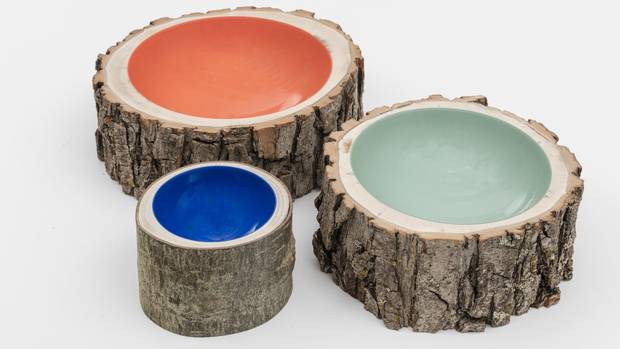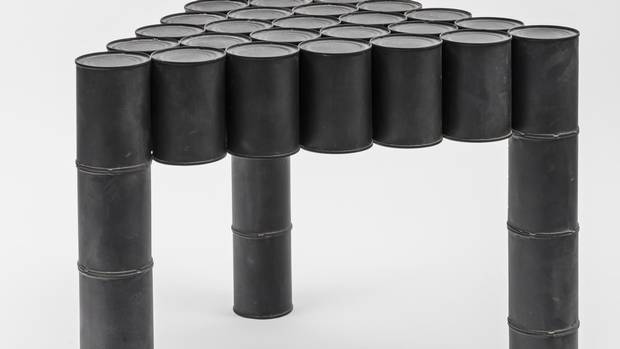There was a time in Canada when the idea of having modern furniture in the home was as repugnant as pouring Cheez Whiz on ice cream. The prevailing aesthetic, writes Gardiner Museum director Kelvin Browne, was led by the country's colonial roots, i.e., ersatz Chippendale or faux French.
Kjeld and Erica Deichmann were of Danish descent but based in New Brunswick, where they started one of Canada’s first studio’s devoted to pottery. Their fanciful Goofus animals (1950-1963) are made of stoneware with an oatmeal glaze.
Toni Hafkenscheid/Gift of Gail and Gerry Crawford
The G2 Stereo, manufactured by Toronto’s Clairtone Sound Corporation, was displayed in something called the “Canadian Cottage” display at the XIII Milan Triennale, one of the world’s top design show of its time. “It says something that all the furniture in the cottage had a Scandinavian influence,” notes Prokopow.
Image courtesy of the Design Exchange
But there was an exception, and it's explored in the Gardiner's excellent new show: True Nordic: How Scandinavia Influenced Design in Canada, which features ceramics, furniture, lighting and textiles. Scandinavian-inspired, Canadian-made design, writes Brown in the exhibit's accompanying book, was "the Trojan Horse of contemporary," surreptitiously sneaking sleek teak tables, credenzas and chairs into otherwise respectably unmodern homes.
Kjeld and Erica Deichmann were of Danish descent but based in New Brunswick, where they started one of Canada’s first studios devoted to pottery. Their fanciful Goofus animals (1950-1963) are made of stoneware with an oatmeal glaze.
New Brunswick Museum

Nature is a source of inspiration common to both Scandinavian and Canadian designers. Calgary-based studio Loyal Loot’s 2004 bowls are made from reclaimed logs with centres surreal, bright centres of acrylic paint.
Toni Hafkenscheid/Courtesy of MADE Design
Part of the appeal was that unlike other forms of modernism, the output from Denmark, Sweden, Norway and Finland wasn't frigidly functional, like so many glass-and-steel office towers. The wood had warmth, the craftsmanship was impeccable and the lines weren't monotonously straight. There were also bursts of colour, particularly in the pottery and textiles (Marimekko's exuberant poppy prints, say). In short, it was humane.
Lorraine Levinson and Esme Gotz admire Canadian textiles on the wall at the True Nordic exhibition at the Gardiner Museum.
JENNIFER ROBERTS FOR THE GLOBE AND MAIL
In the 1960s, Lotte Bostlund, from Oak Ridges, Ont., developed a thriving business, Bostlund Industries, around slip-cast stoneware lamps. “They were shipped all over North America,” says Prokopow. “They used to advertise in the New Yorker.”
Toni Hafkenscheid/Courtesy of Sarah Keenlyside
Dr. Rachel Gotlieb and Dr. Michael Prokopow are both historians and the show's curators. They worked on the exhibit on and off for eight years, collecting the pieces from a wide range of sources, including private collections, other museums, even Value Village. They explain that the roots of Scandinavian design in Canada date back to the 1920s, when emigrants from Northern Europe brought their traditional techniques and craftsmanship. It helped that Canada, with a similar climate and geography, offered access to a complimentary palette of natural materials.
The bright floral Viborg print, made in 1975 by Rexdale, Ont.’s Waldec of Canada, echoes Marimekko’s playful aesthetic. Prokopow found a bolt of the fabric in a Value Village. “It’s possible someone wanted to make a dress out of it, but never got around to it.”
Toni Hafkenscheid
Unlike other forms of modernism, Nordic designs offer warmth and bursts of colour, particularly in the pottery and textiles.
JENNIFER ROBERTS
Prokopow points to someone such as Carl Poul Petersen as an early example. He was born in Copenhagen and apprenticed under famed Danish silversmith Georg Jensen before moving to Canada. An extravagant tea service he designed for the Bronfman family between 1930 and 1945, on loan from the McCord Museum, is one of the show's highlights. "If you look closely you will see how Petersen was blending his Danish sensibility with his Canadian influence," Prokopow says. "There are maple leafs circling the handles."
One of the more unusual pieces on display is the 1975 Ribbon Chair by Denmark-born, Vancouver-based designer Niels Bendtsen. It looks like a duvet suspended in mid-air. The piece is on loan from New York’s Museum of Modern Art.
The Museum of Modern Art
Esme Gotz and Lorraine Levinson admire Canadian studio pottery at the True Nordic exhibition at the Gardiner Museum in Toronto on October 24, 2016.
JENNIFER ROBERTS FOR THE GLOBE AND MAIL
Aside from immigration, international exhibitions brought the latest flavours. At the 1939 World's Fair in New York, for example, the Finnish pavilion, by architect Alvar Aalto caused a sensation with its sinuous, swooping forms. "Designers and the design-educated public paid attention to the World's Fair, and the coverage in the press," Gotlieb says. "The influence started showing up in Canadian designs. And still does. It would be impossible to look at something such as the Integral House designed by [Toronto-based architects] Shim-Sutcliffe, and not see the influence of Aalto."
The pieces in the show range from the mass-produced to the exquisitely bespoke. Leif Jacobsen and Svend Nielsen’s 701 Desk, made in 1974 in Willowdale, Ont., must have been custom-made for someone important; it’s beautifully detailed from fine rosewood.
Collection of Irene and Gord Germann/Image courtesy 507 Antiques
Robert Southcott’s four-chair piece, titled United We Stand, is seen at the True Nordic exhibition at the Gardiner Museum.
Jennifer Roberts for the Globe and Mail
Some of the pieces are, in fact, so similar to original Nordic designs that they almost seem like copies. A bent plywood chair, manufactured in 1946 by the Canadian Wooden Aircraft Company in Stratford, Ont., looks eerily like an earlier (though frankly far better) design by Aalto. Others were even closer copies. A set of candlesticks manufactured by Quebec's Baribocraft almost perfectly mirror ones made by Dansk. "The originals were probably teak," Prokopow says. "Baribocraft made theirs from maple."
Derek Mcleod’s Leather Sling Chair, Brian Richler and Kei Ng’s Deadstock Floor Lamp and Shawn Place’s SP210 Rocking Chair is seen at the True Nordic exhibition.
JENNIFER ROBERTS FOR THE GLOBE AND MAIL
Stacking Chair by Keith Muller and Michael Stewart and Thomas Lamb’s Roo Chair.
JENNIFER ROBERTS for the Globe and Mail
But as time went on, the influence became less direct. "It's remarkable," Gotlieb says, "that in a country as vast as Canada, with so many regional differences, where there hadn't been a dominant design school, Scandinavian became the prevalent aesthetic." And once we embraced it, we keep going with it. "It's interesting," Prokopow says, "because many designers in Northern Europe consider modern Scandinavian design a yoke. They want to move on from it. Whereas it still has a huge influence here."

Donald Lloyd McKinley, a furniture designer who founded the School of Crafts and Design at Sheridan College in Oakville, Ont., took a playful approach to Scandinavian-inspired design. He made, for example, a table entirely out of soup cans. “The piece was influenced by pop art,” says Gotlieb.
Toni Hafkenscheid/Courtesy of Stephen Hogbin
Omer Arbel’s 73 Series Pendant Lamps may tap into tradition but are confidently his own.
JENNIFER ROBERTS for the Globe and Mail
The show culminates with a selection of pieces by top contemporary Canadian designers. Entirely original works that simply echo the craftsmanship, attention to detail and materiality of the modern Scandinavians. There's nothing ersatz about the work of someone such as Vancouver's Omer Arbel, whose milky glass pendant lights cascade from the ceiling like ethereal beings floating from the sky. His pieces might tap into a bigger, longer tradition but are confidently, proudly his own.
Rob Southcott’s 2007 United We Stand chairs take the early Scandinavian influence of bent plywood to a new level, with eccentric strands that twist around each other like interlocking vines.
Robert Southcott
The Fleurt Chair by Andrew Jones, who also designed the exhibition’s displays, has the playful shape of a Marimekko poppy. The piece was the winning entry from an international design competition in 2014 for the seating in Manhattan’s Battery Park.
John Howarth/Courtesy of Andrew Jones
True Nordic is at the Gardiner in Toronto until Jan. 8, when it will be moving to the New Brunswick Museum and then the Vancouver Art Gallery.